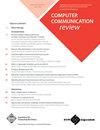Computed Tomography (CT) Unveils Associated Pathology of Deviated Nasal Septum
IF 2.2
4区 计算机科学
Q3 COMPUTER SCIENCE, INFORMATION SYSTEMS
引用次数: 0
Abstract
Background and Objective: Computed Tomography (CT) is the workhorse in the nose and paranasal sinus imaging and depicts not only the complex three-dimensional anatomy, but also the extent of disease and the wide range of anatomic normal variations that are of great importance to the endoscopic septal and sinus surgery. Nasal obstruction is the most frequent presentation to the otolaryngologist all over the world with septal deviation. Septoplasty is the common surgical procedure performed in nasal septal deviation. Physical examination, anterior rhinoscopy (AR) and nasal endoscopy (NE) are considered the gold standard tools to detect septal deviation. This study aimed to find out septal deviation with associated pathologies of nose and paranasal sinuses by using CT scan. Patients and Methods: 188 patients of nasal septal deviation were selected from 2015 to 2019. Age ranged in between 10 year to 70 year of age. CT scanning in both coronal, axial and sagittal sections had been done in all patients after proper history taking, physical examination, anterior rhinoscopy and nasal endoscopy. Endoscopic septoplasty alone and/or other ancillary procedures were performed in all 188 patients under general anesthesia. www.yumedtext.com | August-2020 | ISSN: 2582-5038 | https://dx.doi.org/10.46527/2582-5038.163计算机断层扫描(CT)揭示鼻中隔畸形的相关病理学
背景与目的:计算机断层扫描(CT)是鼻和鼻窦成像的主要工具,它不仅描绘了复杂的三维解剖结构,而且还描绘了疾病的程度和广泛的解剖正常变异,这对鼻中隔和鼻窦内窥镜手术具有重要意义。鼻中隔偏曲是耳鼻喉科医生最常见的症状。鼻中隔成形术是治疗鼻中隔偏曲的常用手术方法。体格检查、前鼻镜检查(AR)和鼻内窥镜检查(NE)被认为是检测鼻中隔偏曲的金标准工具。本研究旨在通过CT扫描发现鼻中隔偏曲与鼻及副鼻窦相关病变。患者与方法:选取2015 - 2019年鼻中隔偏曲患者188例。年龄在10岁到70岁之间。所有患者均经过适当的病史、体格检查、鼻前镜及鼻内窥镜检查,行冠状、轴状、矢状CT扫描。所有188例患者均在全麻下行内窥镜鼻中隔成形术和/或其他辅助手术。www.yumedtext.com | August-2020 | ISSN: 2582-5038 | https://dx.doi.org/10.46527/2582-5038.163
本文章由计算机程序翻译,如有差异,请以英文原文为准。
求助全文
约1分钟内获得全文
求助全文
来源期刊

ACM Sigcomm Computer Communication Review
工程技术-计算机:信息系统
CiteScore
6.90
自引率
3.60%
发文量
20
审稿时长
4-8 weeks
期刊介绍:
Computer Communication Review (CCR) is an online publication of the ACM Special Interest Group on Data Communication (SIGCOMM) and publishes articles on topics within the SIG''s field of interest. Technical papers accepted to CCR typically report on practical advances or the practical applications of theoretical advances. CCR serves as a forum for interesting and novel ideas at an early stage in their development. The focus is on timely dissemination of new ideas that may help trigger additional investigations. While the innovation and timeliness are the major criteria for its acceptance, technical robustness and readability will also be considered in the review process. We particularly encourage papers with early evaluation or feasibility studies.
 求助内容:
求助内容: 应助结果提醒方式:
应助结果提醒方式:


